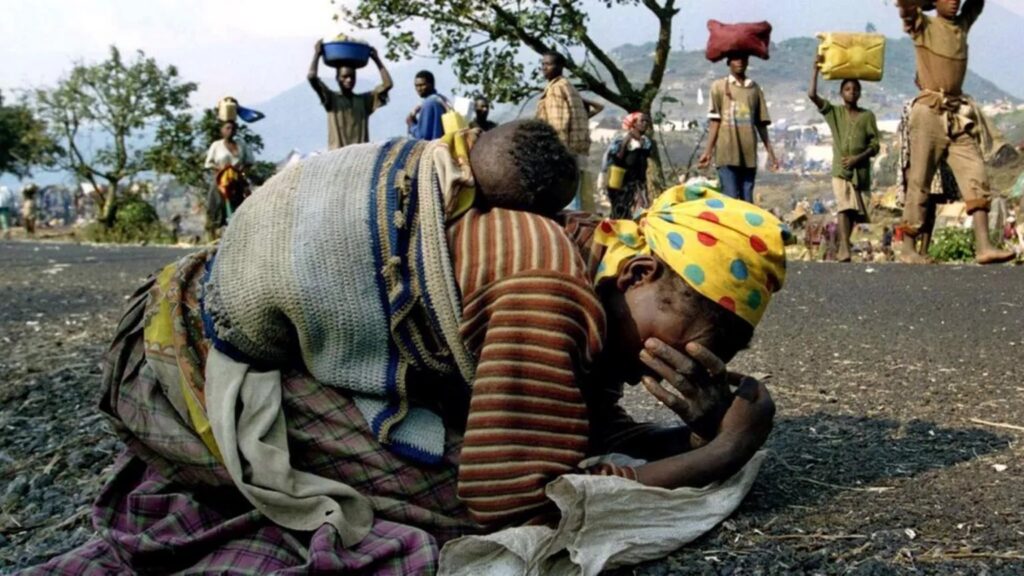- About Ramapo
- Academics
- Admissions & Aid
- Student Life
- Athletics
- Alumni
- Arts & Community
- Quick Links
- Apply
- Visit
- Give
Kwibuka 30, Panel 7
After fleeing the 1994 Genocide Against the Tutsi, a woman collapses to the floor and is overcome with emotions.
Tutsi Women during the Genocide
In 1994, the lives of up to one million Rwandan Tutsi were taken in upwards of 100 days. Hutu extremists, along with civilians of various political orientations began killing and assaulting women, children, and male Tutsi after the assassination of Burundi’s and Rwanda’s Presidents, which was blamed on the Rwandan Patriotic Front. Tutsi women faced sexual violence at the hands of Hutu extremists who wanted to terrorize women and strip them of their Tutsi heritage, while also breaking them down psychologically. They had the assistance of the Rwandan National Guard and the Presidential Guard to help further their political goals of exterminating the Tutsi community. Hutu extremists used rape and murder of Tutsi women as a way of promoting their goals. Due to the violence towards Tutsi women, many attempted to flee to neighboring countries to escape the violence. In addition to murder, Tutsi women faced rape, mutilation, unwanted pregnancies, physiological trauma, and the contraction of diseases such as HIV at the hands of Hutu extremists. In Rwanda, rape and sexual violence is surrounded by a social stigma which silenced Tutsi women survivors from speaking out about the sexual violence they had faced during the genocide. Tutsi women rape survivors were often afraid to speak out, fearing their families or husbands would reject them. Following the genocide, the international community has worked alongside Tutsi women to assist in their recoveries. For example, The Foundation of Rwanda Programme and the Association of Genocide Widows focus on counseling survivors and providing medical attention. Learning about Tutsi women’s experiences during the 1994 Genocide Against the Tutsi is key to understanding the place gender and gendered violence in conflicts and genocides. The gendered aspect of genocide teaches us how sexual violence can mark women’s experiences in conflict zones and genocides, wherein rape can function as a tool of war.
Quick Links
Sexual Violence during the Rwandan Genocide and its Aftermath
Women’s Experiences of Genocide
Bibliography
Blizzard, Sarah Marie. “Women’s Roles in the 1994 Rwanda Genocide and the Empowerment of Women in the Aftermath.” PhD diss., Georgia Institute of Technology, 2006.
Burnet, Jennie E. “Rape as a Weapon of Genocide: Gender, Patriarchy, and Sexual Violence in the Rwandan Genocide.” Anthropology Faculty Publications, 2015.
Drury, Flora. “‘My Father, the Rapist’: Hidden Victims of Rwanda’s Genocide.” BBC News, June 18, 2019.
Lemarchand, René. “The 1994 Rwanda Genocide.” In Century of Genocide: Critical Essays and Eyewitness Accounts, 2nd ed., eds. Samuel Totten and William S. Parsons, 489-504. New York: Routledge, 2009.
Moore, Jina. “This is the Story a UN Court Didn’t Want Three Rape Survivors to Tell.” BuzzFeed News, December 18, 2016.
Mukamana, Donatilla, and Anthony Collins. “Rape survivors of the Rwandan genocide. “Critical Psychology 17 (2006): 140-164.
Nowrojee, Binaifer. Shattered lives: Sexual violence during the Rwandan genocide and its aftermath. Vol. 3169, no. 164. Human Rights Watch, 1996.
“Rwanda, Genocide, Hutu, Tutsi, Mass Execution, Ethnic Cleansing, Massacre, Human Rights, Victim Remembrance, Education, Africa.” United Nations.
Sharlach, Lisa. “Gender and genocide in Rwanda: Women as agents and objects of Genocide.” Journal of Genocide Research 1, no. 3 (1999): 387-399.
Weitsman, Patricia A. “The Politics of Identity and Sexual Violence: A Review of Bosnia and Rwanda.” Human Rights Quarterly 30, no. 3 (2008): 561–78.
Photo Source
Michel, Ulli. “Reporter reflects on Rwanda: ‘Madness took over’.” MPR News. 10 April 2014.
Copyright ©2025 Ramapo College Of New Jersey. Statements And Policies. Contact Webmaster.


Follow Us!